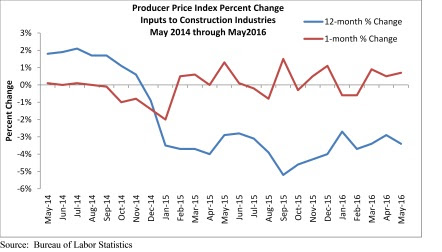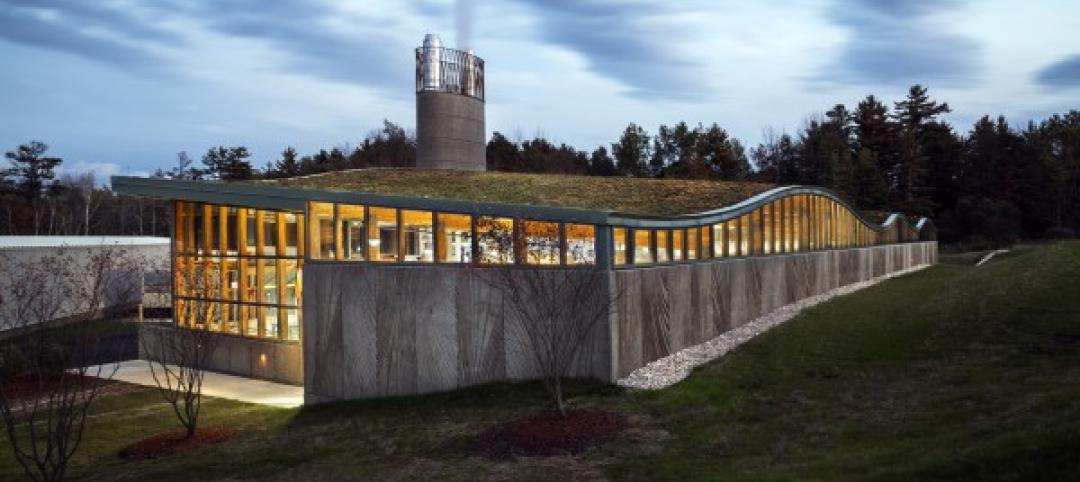Construction input prices expanded by 0.7% in May and have now expanded for three consecutive months according to an analysis of the Bureau of Labor Statistics Producer Price Index released by Associated Builders and Contractors (ABC). The rise follows eight consecutive months during which construction input prices fell; prices remain 3.4% below their year-ago level.
Nonresidential construction input prices expanded by 0.9% in May, but are still 3.5% below their year-ago level. Price gains were largely driven by iron and steel prices and steel mill product prices, which expanded 5.8% and 4.6% for the month, respectively.
"After falling sharply during all of 2015 and into the early months of 2016, an increase in global commodities prices had to happen as markets firmed," said ABC Chief Economist Anirban Basu. "While much attention has been given to the recent rise in oil prices to around $50 per barrel, other commodity prices have also experienced a resurgence, including iron ore.
"That said, the global economy continues to disappoint relative to expectations established at the start of the year," said Basu. "Higher prices may stimulate new rounds of production, including in energy markets, but the implication is that prices are unlikely to rise smoothly or dramatically going forward. Analyst views regarding the direction of commodity prices diverge wildly. While supply and demand play a role in fashioning commodity prices, so too does the value of the U.S. dollar. U.S. interest rates remain low and in many cases have been declining. The dollar has correspondingly weakened in recent weeks. Should that continue, commodity price increases could be sharper than we presently anticipate."

Nine key input prices expanded or remained unchanged in May on a monthly basis:
- Crude petroleum prices expanded 0.6% from April 2016, but are down 32.5% from May 2015.
- Unprocessed energy material prices expanded 0.9% on a monthly basis, but have fallen 23.1% on a year-ago basis.
- Prices for steel mill products expanded 4.6% from a month ago, but are down 5.2% on a yearly basis.
- Iron and steel prices expanded 5.8% month-over-month, but are down 2% year-over-year.
- Softwood lumber prices expanded 2.2% for the month and 6.3% from May 2016.
- Fabricated structural metal prices remained unchanged month-over-month and are down 1.9% year-over-year.
- Prices for plumbing fixtures and fittings expanded 0.2% for the month and are up 0.3% from the same time last year.
- Prices for prepared asphalt and tar and roofing and siding products expanded by 0.4% month-to-month and 0.7% year-over-year.
- Natural gas prices rose 2.9% for the month, but are down 23.5% from the same period one year ago.
Two key input prices declined on a monthly basis:
- Nonferrous wire and cable prices fell 1.3% on a monthly basis and have fallen 9.2% on a yearly basis.
- Concrete product prices inched down by 0.1% month-over-month, but are up 3% year-over-year.
Related Stories
| Mar 21, 2014
Forget wood skyscrapers - Check out these stunning bamboo high-rise concepts [slideshow]
The Singapore Bamboo Skyscraper competition invited design teams to explore the possibilities of using bamboo as the dominant material in a high-rise project for the Singapore skyline.
| Mar 20, 2014
Common EIFS failures, and how to prevent them
Poor workmanship, impact damage, building movement, and incompatible or unsound substrate are among the major culprits of EIFS problems.
| Mar 20, 2014
13 dazzling wood building designs [slideshow]
From bold structural glulam designs to striking textured wall and ceiling schemes, these award-winning building projects showcase the design possibilities using wood.
| Mar 19, 2014
Federal agency gives thumbs up to tall wood buildings
USDA's support for wood projects includes training for AEC professionals and a wood high-rise design competition, to launch later this year.
| Mar 17, 2014
Rem Koolhaas explains China's plans for its 'ghost cities'
China's goal, according to Koolhaas, is to de-incentivize migration into already overcrowded cities.
| Mar 12, 2014
14 new ideas for doors and door hardware
From a high-tech classroom lockdown system to an impact-resistant wide-stile door line, BD+C editors present a collection of door and door hardware innovations.
| Mar 10, 2014
Meet Tally – the Revit app that calculates the environmental impact of building materials
Tally provides AEC professionals with insight into how materials-related decisions made during design influence a building’s overall ecological footprint.
| Mar 5, 2014
5 tile design trends for 2014
Beveled, geometric, and high-tech patterns are among the hot ceramic tile trends, say tile design experts.
| Mar 4, 2014
How EIFS came to America
Design experts from Hoffmann Architects offer a brief history of exterior insulation and finish systems in the U.S.
| Feb 27, 2014
12 facts about heat-treated glass: Why stronger isn’t always better
Glass is heat-treated for two reasons: the first is to increase its strength to resist external stresses such as wind and snow loads, or thermal loads caused by the sun’s energy. The second is to temper glass so that it meets safety glazing requirements defined by applicable codes or federal standards.

















